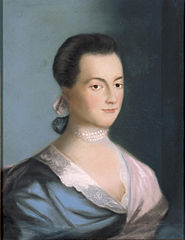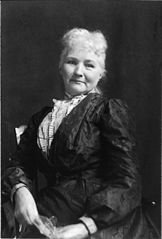Defining Ourselves
I am taking a break from the broom this week. In honor of Women’s History Month, I wanted to post something about American women’s political history as it relates to worship.Women have not always been women. We’ve been (among other things) wenches, maidens, girls, damsels and, of course, ladies. These words have usually referred to status as well as gender, but whatever her status, the definition of the word and the word itself was one in which the poor wench had no voice.Abigail Adams, first lady to the second president of the United States, addressed the topic of women’s voices in 1776, as the principles of the new nation were being formed. In a letter to her husband she admonished, “If particular care and attention is not paid to the ladies, we are determined to foment a rebellion, and will not hold ourselves bound by any laws in which we have no voice, or representation.” The use of “ladies” in such a strongly worded feminist statement sounds jarring, but “lady” was the word in vogue at the time. “Woman” was impolite or dehumanizing, implying low status, referring to bodies and therefore vaguely acknowledging sex. “Lady” was the genteel, civilized, respectable, well-mannered ideal.Seventy-five years later, the first wave of American feminists rejected the word “lady” as a construct imposed by men, affirming instead the word “woman.” This took the definition of the female sex away from the realm of behavior, putting it back on the body and enabling women to do unladylike things. Even labor organizer Mary “Mother” Jones, who had her own disagreements with feminists, got the importance of this when she admonished young women, “No matter what the fight, don’t be ladylike. God almighty made women, and the Rockefeller gang of thieves made the ladies.”In the second wave of feminism, beginning in the late 1960’s, women reaffirmed themselves as women, pushing back against the “lady” and “girl” monikers and celebrating the being and the body that God almighty made, only this time we called her “Goddess.” “Lady” was increasingly being limited to a polite means of addressing a female stranger (although “gentleman” was rarely used in this context). “Hey lady! Zip up your purse–you’re in New York!” a man yelled at me once. The upper class connotations of “lady” had long been a point of discomfort in a society that rejected the idea of class in principle, if not in practice. The word “lady” continued to be embraced by conservative women as an affirmation of the old male-imposed ideals or even as a code word for anti-feminist. The eighties street theatre group “Ladies Against Women” parodied these anti-feminist ladies.For all its baggage of snobbery and oppression, the word “lady” remains ensconced in certain pagan traditions, particularly those that are an offshoot of British traditional witchcraft. The most conservative traditions worship a “Lord and Lady,” not a “God and Goddess,” and the high priestess may be addressed in circle as “lady.” A woman who has completed the highest level of training may also be addressed as lady. Once in awhile, a high priestess will publish a book under a pen name of Lady SomethingOrOther, but the title is not used outside of Craft business.Hungarian-born Dianic leader Z Budapest tried unsuccessfully to persuade Dianic priestesses to accept the word “lady” in sacred context, arguing that the word originally meant “maker of the loaf” and has not always been a label of oppression. In feminist circles, resistance was too high to continue this traditional form of reference. For Dianics the word “woman” continues to be preferred, a way of affirming that we are not to be defined by outside forces.


